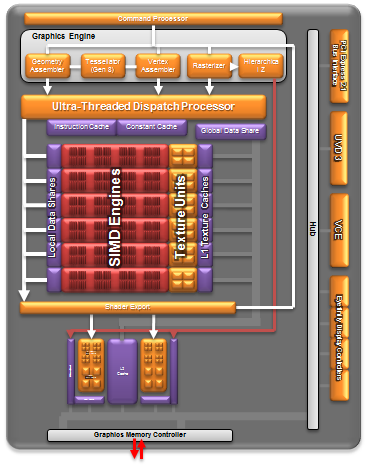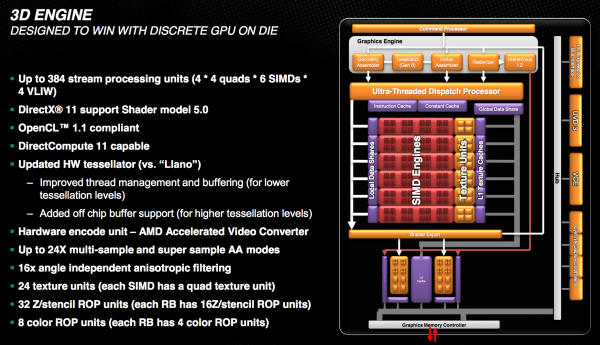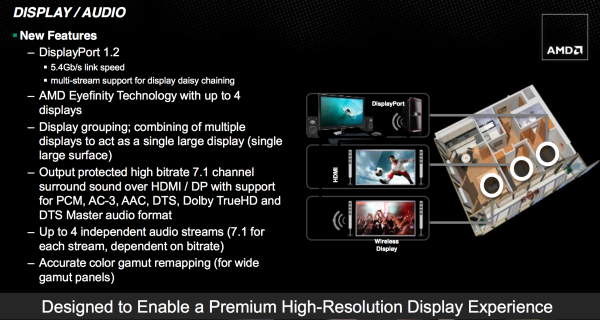The AMD Trinity Review (A10-4600M): A New Hope
by Jarred Walton on May 15, 2012 12:00 AM ESTImproved Turbo
Trinity features a much improved version of AMD's Turbo Core technology compared to Llano. First and foremost, both CPU and GPU turbo are now supported. In Llano only the CPU cores could turbo up if there was additional TDP headroom available, while the GPU cores ran no higher than their max specified frequency. In Trinity, if the CPU cores aren't using all of their allocated TDP but the GPU is under heavy load, it can exceed its typical max frequency to capitalize on the available TDP. The same obviously works in reverse.
Under the hood, the microcontroller that monitors all power consumption within the APU is much more capable. In Llano, the Turbo Core microcontroller looked at activity on the CPU/GPU and performed a static allocation of power based on this data. In Trinity, AMD implemented a physics based thermal calculation model using fast transforms. The model takes power and translates it into a dynamic temperature calculation. Power is still estimated based on workload, which AMD claims has less than a 1% error rate, but the new model gets accurate temperatures from those estimations. The thermal model delivers accuracy at or below 2C, in real time. Having more accurate thermal data allows the turbo microcontroller to respond quicker, which should allow for frequencies to scale up and down more effectively.
At the end of the day this should improve performance, although it's difficult to compare directly to Llano since so much has changed between the two APUs. Just as with Llano, AMD specifies nominal and max turbo frequencies for the Trinity CPU/GPU.
A Beefy Set of Interconnects
The holy grail for AMD (and Intel for that matter) is a single piece of silicon with CPU and GPU style cores that coexist harmoniously, each doing what they do best. We're not quite there yet, but in pursuit of that goal it's important to have tons of bandwidth available on chip.
Trinity still features two 64-bit DDR3 memory controllers with support for up to DDR3-1866 speeds. The controllers add support for 1.25V memory. Notebook bound Trinities (Socket FS1r2 and Socket FP2) support up to 32GB of memory, while the desktop variants (Socket FM2) can handle up to 64GB.
Hyper Transport is gone as an external interconnect, leaving only PCIe for off-chip IO. The Fusion Control Link is a 128-bit (each direction) interface giving off-chip IO devices access to system memory. Trinity also features a 256-bit (in each direction, per memory channel) Radeon Memory Bus (RMB) direct access to the DRAM controllers. The excessive width of this bus likely implies that it's also used for CPU/GPU communication as well.
IOMMU v2 is also supported by Trinity, giving supported discrete GPUs (e.g. Tahiti) access to the CPU's virtual memory. In Llano, you used to take data from disk, copy it to memory, then copy it from the CPU's address space to pinned memory that's accessible by the GPU, then the GPU gets it and brings it into its frame buffer. By having access to the CPU's virtual address space now the data goes from disk, to memory, then directly to the GPU's memory—you skip that intermediate mem to mem copy. Eventually we'll get to the point where there's truly one unified address space, but steps like these are what will get us there.
The Trinity GPU
Trinity's GPU is probably the most well understood part of the chip, seeing as how its basically a cut down Cayman from AMD's Northern Islands family. The VLIW4 design features 6 SIMD engines, each with 16 VLIW4 arrays, for a total of up to 384 cores. The A10 SKUs get 384 cores while the lower end A8 and A6 parts get 256 and 192, respectively. FP64 is supported but at 1/16 the FP32 rate.

As AMD never released any low-end Northern Islands VLIW4 parts, Trinity's GPU is a bit unique. It technically has fewer cores than Llano's GPU, but as we saw with AMD's transition from VLIW5 to VLIW4, the loss didn't really impact performance but rather drove up efficiency. Remember that most of the time that 5th unit in AMD's VLIW5 architectures went unused.
The design features 24 texture units and 8 ROPs, in line with what you'd expect from what's effectively 1/4 of a Cayman/Radeon HD 6970. Clock speeds are obviously lower than a full blown Cayman, but not by a ton. Trinity's GPU runs at a normal maximum of 497MHz and can turbo up as high as 686MHz.
Trinity includes AMD's HD Media Accelerator, which includes accelerated video decode (UVD3) and encode components (VCE). Trinity borrows Graphics Core Next's Video Codec Engine (VCE) and is actually functional in the hardware/software we have here today. Don't get too excited though; the VCE enabled software we have today won't take advantage of the identical hardware in discrete GCN GPUs. AMD tells us this is purely a matter of having the resources to prioritize Trinity first, and that discrete GPU VCE support is coming.















271 Comments
View All Comments
duploxxx - Tuesday, May 15, 2012 - link
if you want a more responsive laptop then buy an SSD, no one needs a laptop like the recent released Intel QC that turbo up all the way to 3.xxx whalhalle GHZ... its disc performance that is lacking most.jabber - Tuesday, May 15, 2012 - link
Exactly.My main laptop that I use most of the day is a 1.3Ghz CULV dual core from Intel. It does everything I need as a roving PC engineer. It benches the same as an old PentiumD 2.8Ghz.
If I put a SSD in it (which I want to) then I'd probably struggle to tell it apart day to day from one with a i5 cpu in it. CPU makes no difference to me.
Since dual cores came out in 2005/6 customers dont notice CPU upgrades all that much. You put a SSD in though and they notice that. Oh and if they can play WoW or Sims with the trimmings then they love that too.
Once again is it possible to add the latest Sims game to the benchmarks list? I dont play it myself but nearly every teens laptop I get has it on and I do get asked about good laptops for such a game.
BSMonitor - Tuesday, May 15, 2012 - link
Roving PC engineer? You mean you go to meetings and look at Word Documents. That hardly makes you the "average" user. The rest of us do the actual work.Spunjji - Wednesday, May 16, 2012 - link
Look up the meaning of the word average.CeriseCogburn - Thursday, May 24, 2012 - link
I'll monitor this one - since really old cpu's are way more than enough grunt since the trinity cpu sucks so badly and amd needs another gigantic hand of endless applause and praise by many frenetic amd fans flavoring up the place, we have learned one thing -All the old laptops are just fine. If you have a discrete of any sort, just use that. Add a little cheap ram, or add an SSD and it will beat trinity no problem all the time.
I thank all the trinity lovers for the hot tip - no one needs a trinity laptop.
BSMonitor - Tuesday, May 15, 2012 - link
Not for facebooking and trolling no. But I do real work on my PC.Spunjji - Tuesday, May 15, 2012 - link
Name the part of their CPU performance that doesn't meet the "good enough" metric. Seriously, convince me of your argument. So far it sounds like the usual crap I hear from people who don't understand the average user's needs.BSMonitor - Tuesday, May 15, 2012 - link
And you speak for "average" user like you know 100 million business users. I work in an IT shop. It took years of convincing to get off our P4's to Core2Duo. Because management takes the "good enough" stance like you. Waiting for email client base on JAVA runtime is NOT acceptable. Having Adobe reader pages lag when browsing them, re-sizing, is NOT acceptable. It STILL lags behind my Core i7 machine at home. And is VERY noticeable.Again, ebay, FB, yahoo... These are not the majority of users who care about performance.
In regards to 14 y/o's and housewives, yes, trinity rules. But then so did those laptops from 6 years ago. For them.
sumguy+4 - Tuesday, May 15, 2012 - link
So you are claiming that Intel's performance has improved by only 20% over the past 6 years??!?The article's summary stated that Trinity's CPU deficit vs Intel is 20-25% (while being cheaper and offering better video perf)
Show us the mobile CPU from 6 years ago that could even come close.
juampavalverde - Tuesday, May 15, 2012 - link
Wait... youre using and email client? haha... and its based on java? LOL!. And youre using adobe reader? ROTFL!A great part of the performance comes using software that gets all the juice from the hardware you have, there is no need even in the newest systems to use so bloated software.
By the way, i have an old HP 6910p with a C2D and 2 GB DDR2, GM965, it kicks butt and im thinking to throw a cheap SSD on it because is good enough to do any task i need to do (office apps, web apps, remote connections).